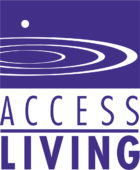Access Living, Centers for Independent Living, and Serving Disabled Survivors
Access Living was founded in 1980 as the Center for Independent Living serving the City of Chicago. Centers for Independent Living (CILs) are nonprofits that provide disability services and advocacy as designated by the Rehabilitation Act of 1973. For CILs to receive federal funding under that law, more than 50% of the CIL staff and board must be people with disabilities. There are over 300 CILs across the United States. According to the Administration on Community Living (ACL), CILs are federally required to provide the following services and programming:
- Information and referrals
- Independent living skills training
- Peer counseling
- Individual and systems advocacy
- Services that facilitate transition from nursing homes and other institutions to the community
- Services that provide assistance to those at risk of entering institutions
- Services that facilitate transition of youth to postsecondary life
CILs are each assigned a specific service jurisdiction, usually one or more counties. In Illinois, 22 CILs serve all 102 counties in Illinois. Access Living is unique among the Illinois CILs in that our service area is a single large city in one county: the City of Chicago, which has around 2.7 million people, according to 2022 U.S. Census Bureau data. Progress Center for Independent Living serves the rest of Cook County outside the city of Chicago.
Anecdotally, CILs across the country have served hundreds, if not thousands, of disabled gun violence survivors in their local jurisdictions over the decades. Some experienced gun violence in the military or in law enforcement; many others became disabled through community gun violence. Access Living has served many people in the latter category over the last 40 years. As an organization rooted in our specific service area, we have been highly aware of the effects of community gun violence — in terms of how it results in people acquiring disabilities, and how it leads to new social dynamics that many suddenly newly disabled people experience with family, friends, employers and others in their communities. However, our ongoing community conversations with Chicagoans with disabilities showed us that much more needed to be done to serve those becoming disabled through community gun violence.
Since 2010, more than 37,000 non-fatal shooting incidents occurred in Chicago [4]. This is, frankly, an astounding number. We believe that potentially thousands of gun violence survivors in Access Living’s service area have resulting permanent physical disabilities, traumatic brain injuries, and mental or emotional disabilities. In recent years, we heard over and over from community members that they, or people they know, have had no idea how to learn to live their new lives as people with disabilities. We knew we had to do something about this, for the sake not only of survivors, but for all of Chicago’s communities.
After we resolved to develop our capacity to better serve disabled survivors of gun violence, we knew that a certain kind of advance work would be needed. We had to ensure we truly understand the issues and neighborhoods we are serving. We knew we had to center the work in the lived experience of Chicago’s Black and Latinx communities. As part of the commitment to lived experience, we know we would have to step up to any needed advocacy for investment in appropriate, essential community resources. We also knew that our staff would need education to become well-versed in this topic, so they can help in a supportive, trauma-informed and humanistic way.
In the next section, we detail the advance work we did to prepare for meaningful support and service for disabled survivors of gun violence.
[4] City of Chicago Violence Reduction Dashboard, Violence and Victimization Trends 2010-2023. See https://www.chicago.gov/city/en/sites/vrd/home.html. Accessed March 2024.
